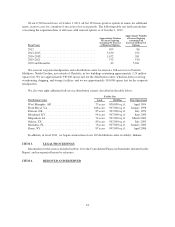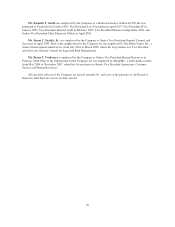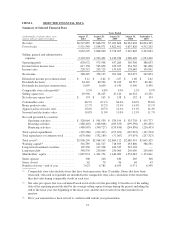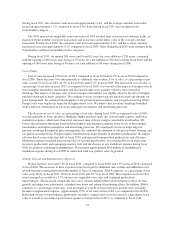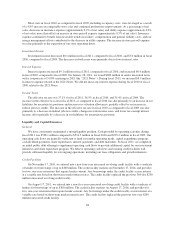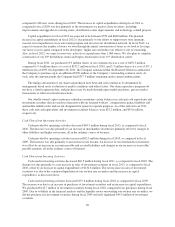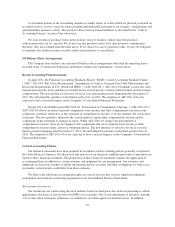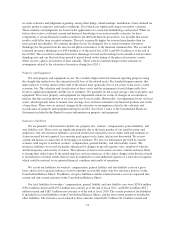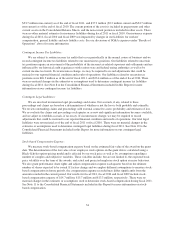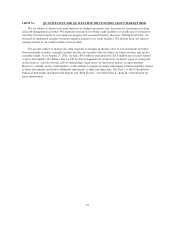Family Dollar 2011 Annual Report Download - page 31
Download and view the complete annual report
Please find page 31 of the 2011 Family Dollar annual report below. You can navigate through the pages in the report by either clicking on the pages listed below, or by using the keyword search tool below to find specific information within the annual report.During fiscal 2011, the customer count increased approximately 4.0%, and the average customer transaction
increased approximately 1.5% compared to fiscal 2010. Sales during fiscal 2011 were strongest in the
Consumables category.
The 4.8% increase in comparable store sales in fiscal 2010 resulted from an increase in customer traffic, as
measured by the number of register transactions and an increase in the dollar value of the average customer
transaction. During fiscal 2010, the customer count increased approximately 4.3%, and the average customer
transaction increased approximately 0.5% compared to fiscal 2009. Sales during fiscal 2010 were strongest in the
Consumables and Seasonal and Electronics categories.
During fiscal 2011, we opened 300 stores and closed 62 stores for a net addition of 238 stores, compared
with the opening of 200 stores and closing of 70 stores for a net addition of 130 stores during fiscal 2010, and the
opening of 180 stores and closing of 96 stores for a net addition of 84 stores during fiscal 2009.
Cost of Sales
Cost of sales increased 9.0% in fiscal 2011 compared to fiscal 2010 and 4.9% in fiscal 2010 compared to
fiscal 2009. These increases were due primarily to additional sales volume. Cost of sales, as a percentage of net
sales, was 64.5% in fiscal 2011, 64.3% in fiscal 2010, and 65.2% in fiscal 2009. The increase in cost of sales, as
a percentage of net sales in fiscal 2011, as compared to fiscal 2010, was a result of the impact of stronger sales in
lower margin consumables merchandise and increased freight costs, partially offset by lower inventory
shrinkage. The impact of stronger sales of lower margin consumables was slightly offset by the effect of higher
purchase mark-ups in many categories. We continue to focus on improving our purchase mark-ups through our
price management, the continued development of our private brand assortment, and our global sourcing efforts.
Freight costs were negatively impacted by higher diesel costs. We believe that inventory shrinkage benefited
from workforce stabilization in our stores and improved analytics and monitoring processes.
The decrease in cost of sales, as a percentage of net sales, during fiscal 2010 as compared to fiscal 2009,
was due primarily to lower inventory shrinkage, higher purchase mark-ups, lower freight expense, and lower
markdown expense, which more than offset increased sales of lower-margin consumable merchandise. We
believe that inventory shrinkage benefited from higher store manager retention, lower levels of discretionary
merchandise and improved analytics and monitoring processes. We continued to focus on improving our
purchase mark-ups through our price management, the continued development of our private brand offering, and
our global sourcing efforts. Freight expense benefited from improvements in inventory productivity, the impact
of lower diesel costs on the first half of fiscal 2010, and increased transportation productivity and efficiency.
Markdown expense benefited from strong sales of seasonal merchandise, our continued focus on improving
inventory productivity and managing inventory risk, and the absence of any markdown expense during fiscal
2010 for products containing lead/phthalates. We incurred approximately $6.8 million of lead/phthalate
markdown expense during fiscal 2009 in connection with new product safety legislation.
Selling, General and Administrative Expenses
SG&A expenses increased 7.2% in fiscal 2011, compared to fiscal 2010, and 5.3% in fiscal 2010, compared
to fiscal 2009. The increases in these expenses were due in part to additional sales volume and additional costs
arising from the continued growth in the number of stores in operation. SG&A expenses, as a percentage of net
sales, were 28.0% in fiscal 2011, 28.4% in fiscal 2010, and 28.7% in fiscal 2009. Most expenses in fiscal 2011
were leveraged as a result of a 5.5% increase in comparable store sales and continued productivity
improvements. The increased comparable store sales volumes helped offset our investments to drive revenue
growth, including store renovations, extended store hours and enhanced marketing efforts. In addition, SG&A
expenses, as a percentage of net sales, were leveraged as a result of lower non-store payroll costs, including
incentive compensation expense, (approximately 0.3% of net sales) in fiscal 2011, as compared to fiscal 2010.
Reflecting our pay-for-performance philosophy, incentive compensation costs decreased as a percentage of net
sales as a result of our relative performance against our target in fiscal 2011, as compared to fiscal 2010.
27



